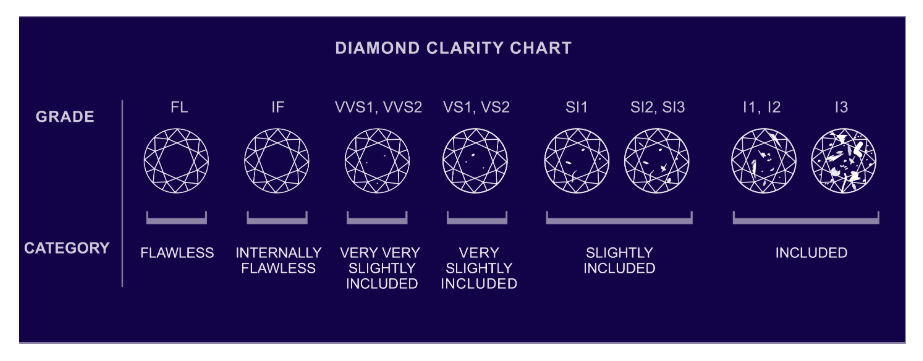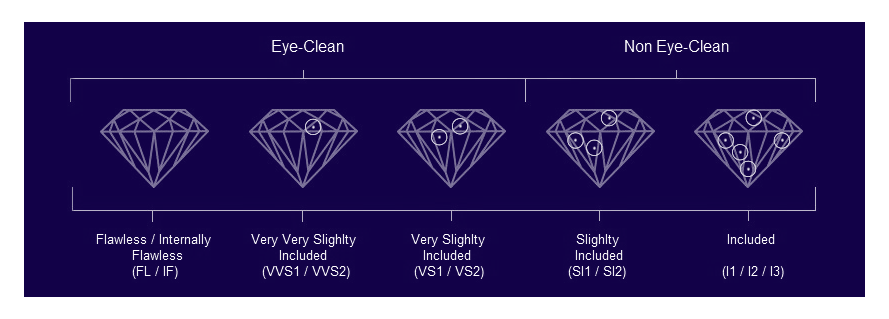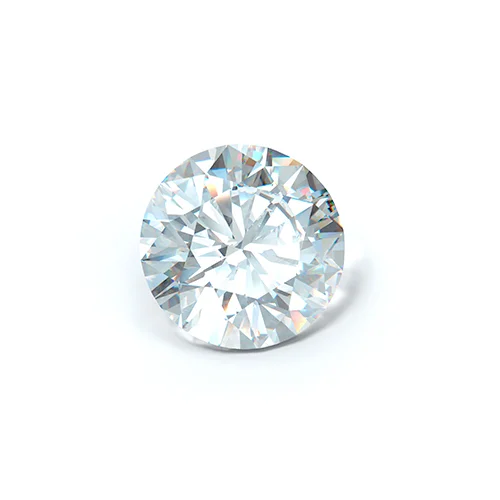
Diamonds are a popular choice for engagement rings and other fine jewelry, but not all diamonds are created equal. One of the most important factors to consider when choosing a diamond is its clarity. In this guide, we’ll break down everything you need to know about diamond clarity.
What is Diamond Clarity?
Diamond clarity refers to the absence or presence of inclusions and blemishes within a diamond. Inclusions are internal imperfections such as tiny crystals, clouds, or feathers, while blemishes are external imperfections such as scratches or chips. The presence of inclusions and blemishes can affect the diamond’s overall appearance and value. Diamonds with fewer inclusions and blemishes are considered more valuable and sought after.
How is Diamond Clarity Graded?
Diamond clarity is graded on a scale that ranges from Flawless (FL) to Included (I3). The clarity grades are determined by examining the diamond under 10x magnification and evaluating the size, location, number, and type of inclusions and blemishes.
- Flawless (FL) and Internally Flawless (IF): Diamonds in this category have no visible inclusions or blemishes under 10x magnification. These diamonds are extremely rare and valuable.
- Very, Very Slightly Included (VVS1 and VVS2): Diamonds in this category have inclusions that are very difficult to see under 10x magnification. These diamonds are also rare and valuable.
- Very Slightly Included (VS1 and VS2): Diamonds in this category have inclusions that are visible under 10x magnification, but they are minor and do not affect the diamond’s overall appearance. These diamonds are a popular choice for engagement rings.
- Slightly Included (SI1 and SI2): Diamonds in this category have inclusions that are noticeable under 10x magnification but are still not visible to the naked eye. These diamonds offer a great balance of value and quality.
- Included (I1, I2, and I3): Diamonds in this category have inclusions that are visible to the naked eye and can affect the diamond’s overall appearance and durability.

What Factors Affect Diamond Clarity?
Several factors can affect a diamond’s clarity, including: Size and Number of Inclusions: The size and number of inclusions can affect the diamond’s clarity grade. The more significant and numerous the inclusions, the lower the clarity grade. Location of Inclusions: The location of the inclusions can also affect the diamond’s clarity. Inclusions that are located in the center of the diamond are more visible and can lower the clarity grade. Type of Inclusions: The type of inclusions can affect the diamond’s clarity as well. Some inclusions, such as feathers, can affect the diamond’s durability and may cause it to break or chip. Cut: The cut of the diamond can also affect its clarity. A well-cut diamond can minimize the appearance of inclusions and blemishes and enhance the diamond’s overall brilliance and sparkle.
How to Choose a Diamond Based on Clarity
When choosing a diamond based on clarity, there are several factors to consider:
- Budget: Diamonds with higher clarity grades are more valuable and, therefore, more expensive. Consider your budget and prioritize the other factors accordingly.
- Personal Preference: Some people prefer diamonds with higher clarity grades, while others may not mind visible inclusions as long as they don’t affect the overall appearance of the diamond.
- Size and Type of Inclusions: Consider the size and type of inclusions and their location within the diamond. Inclusions that are located near the edges of the diamond are less visible and may not affect the

